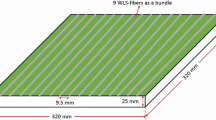Abstract
Purpose
A novel fast neutron scatter camera with capabilities of neutron imaging and spectroscopy is under development. The detection principle is based on multiple neutron–proton (n–p) elastic scattering interactions in organic scintillator. In order to improve position measurement accuracy of recoil protons, a position-sensitive prototype detector unit has been designed and characterized experimentally.
Methods
The presented detector unit consisted of a plastic scintillator sheet of 10 cm × 10 cm × 1 cm dimensions and two groups (6 × 2) of wavelength-shifting fibers with orthogonal directions embedded into grooves on two opposite scintillator surfaces. Scintillation signals were read out by silicon photomultipliers (SiPMs). A collimated Sr-90 radioactive source was utilized for system calibration and position resolution measurement.
Results
Light output of the unidimensional six fiber channels from one side of the detector unit was calibrated to be 14.45 photoelectrons per MeVee. Position resolution of the detector unit was measured to be 0.35–0.44 times fiber pitch, corresponding to 5.48 mm for proton recoil energy interval of 1.63–2.60 MeV, and 4.60 mm for proton recoil energy interval of 4.82–5.50 MeV. Energy threshold for recoil proton localization was estimated to be 1.18 MeV.
Conclusion
The results shown satisfy basic requirements of the scatter camera, while space exists for further improvements. The positioning performance optimization consists of three aspects. The first one is to increase the fiber diameter so as to reduce signal loss. The second one is to depress dark rate of the SiPMs. The last one is to decrease the number of channels involved in position reconstruction by narrowing the scintillation signal distribution function of the detector unit.


















Similar content being viewed by others
References
G.F. Knoll, Radiation Detection and Measurement, 4th edn. (Wiley, New York, 2010)
P. Marleau, et al., Advances in imaging fission neutrons with a neutron scatter camera. in IEEE Nuclear Science Symposium Conference Record, pp. 170–172 (2007). https://doi.org/10.1109/NSSMIC.2007.4436310
N. Mascarenhas et al., Results with the neutron scatter camera. IEEE Trans. Nucl. Sci. 56(3), 1269–1273 (2009). https://doi.org/10.1109/TNS.2009.2016659
J. Brennan, et al. Applying the neutron scatter camera to treaty verification and warhead monitoring. in IEEE Nuclear Science Symposium and Medical Imaging Conference Record, pp. 691–694 (2010). https://doi.org/10.1109/NSSMIC.2010.5873848
A. Poitrasson-Rivière et al., Dual-particle imaging system based on simultaneous detection of photon and neutron collision events. Nucl. Instrum. Methods Phys. Res. A 760, 40–45 (2014). https://doi.org/10.1016/j.nima.2014.05.056
A. Poitrasson-Rivière et al., Angular-resolution and material-characterization measurements for a dual-particle imaging system with mixed-oxide fuel. Nucl. Instrum. Methods Phys. Res. A 797, 278–284 (2015). https://doi.org/10.1016/j.nima.2015.06.045
A. Poitrasson-Rivière et al., Monte Carlo investigation of a high-efficiency, two-plane Compton camera for long-range localization of radioactive materials. Prog. Nucl. Energy 81, 127–133 (2015). https://doi.org/10.1016/j.pnucene.2015.01.009
K. Weinfurther et al., Model-based design evaluation of a compact, high-efficiency neutron scatter camera. Nucl. Instrum. Methods Phys. Res. A 883, 115–135 (2018). https://doi.org/10.1016/j.nima.2017.11.025
Beijing Gaonengkedi Science and Technology Co. Ltd. Plastic Scintillator. http://www.gaonengkedi.com
Z. Zong et al., Study of light yield for different configurations of plastic scintillators and wavelength shifting fibers. Nucl. Instrum. Methods Phys. Res. A 908, 82–90 (2018). https://doi.org/10.1016/j.nima.2018.08.029
Saint-Gobain Crystals, Plastic Scintillator. https://www.crystals.saint-gobain.com/products/plastic-scintillators
Saint-Gobain Crystals, Plastic Fiber. https://www.crystals.saint-gobain.com/products/scintillating-fiber
Advantech UK Limited, Silicon photomultiplier. https://www.advatech-uk.co.uk/sipms.html
F. Shi et al., Comparative studies of silicon photomultipliers and traditional vacuum photomultiplier tubes. Chin. Phys. C 35(1), 50–55 (2011). https://doi.org/10.1088/1674-1137/35/1/011
S. Riggi et al., Geant4 simulation of plastic scintillator strips with embedded optical fibers for a prototype of tomographic system. Nucl. Instrum. Methods Phys. Res. A 624, 583–590 (2010). https://doi.org/10.1016/j.nima.2010.10.012
3M, Vikuiti Enhanced Specular Reflector (ESR)—ESR Sales Literature, 2010
Saint-Gobain Crystals, Assembly Materials. https://www.crystals.saint-gobain.com/products/assembly-materials
G. Dietze, H. Klein, Gamma-calibration of NE 213 scintillation counters. Nucl. Instrum. Methods 193, 549–556 (1982). https://doi.org/10.1016/0029-554X(82)90249-X
M. Yang et al., Measurement of proton quenching in a LAB-based liquid scintillator. Radiat. Detect. Technol. Methods (2019). https://doi.org/10.1007/s41605-018-0049-z
NIST, ESTAR: Stopping-power and Range Tables for Electrons, 2015. https://physics.nist.gov/PhysRefData/Star/Text/ESTAR.html
Saint-Gobain Crystals, Organic Scintillation Materials and Assemblies brochure. https://www.crystals.saint-gobain.com
V.V. Verbinski, W.R. Burrus, T.A. Love, W. Zobel, N.W. Hill, R. Textor, Calibration of an organic scintillator for neutron spectrometry. Nucl. Instrum. Methods 65, 8–25 (1968). https://doi.org/10.1016/0029-554X(68)90003-7
M. R. Moser. Theoretical contributions to the development of neutron scatter telescopes for fast neutron observation in space. PhD Thesis, University of Bern, Bern, Switzerland, 2006, pp. 84-89
G. Landi et al., Properties of the center of gravity as an algorithm for position measurements. Nucl. Instrum. Methods Phys. Res. A 485, 698–719 (2002). https://doi.org/10.1016/S0168-9002(01)02071-X
G. Landi et al., Properties of the center of gravity as an algorithm for position measurements: two-dimensional geometry. Nucl. Instrum. Methods Phys. Res. A 497, 511–534 (2003). https://doi.org/10.1016/S0168-9002(02)01822-3
朱永生,实验物理中的概率和统计(第二版),北京:科学出版社,2006
J.B. Birks, The Theory and Practice of Scintillation Counting (Pergamon Press Ltd, New York, 1964)
F.D. Brooks, Development of organic scintillators. Nucl. Instrum. Methods 162, 477–505 (1979). https://doi.org/10.1016/0029-554X(79)90729-8
R. Voltz, J.L. Silva, G. Laustriat, A. Coche, Influence of the nature of ionizing particles on the specific luminescence of organic scintillators. J. Chem. Phys. 45, 3306–3311 (1966). https://doi.org/10.1063/1.1728106
S.P. Ahlen, B.G. Cartwright, G. Tarlé, Return to unsaturated response of polymeric scintillators excited by relativistic heavy ions. Nucl. Instrum. Methods 147, 321–328 (1977). https://doi.org/10.1016/0029-554X(77)90264-6
M.A. Norsworthy et al., Evaluation of neutron light output response functions in EJ-309 organic scintillators. Nucl. Instrum. Methods Phys. Res. A 842, 20–27 (2017). https://doi.org/10.1016/j.nima.2016.10.035
M. Janecek, W.W. Moses, Optical reflectance measurements for commonly used reflectors. IEEE Trans. Nucl. Sci. 55(4), 2432–2437 (2008). https://doi.org/10.1109/TNS.2008.2001408
M. Janecek, Reflectivity spectra for commonly used reflectors. IEEE Trans. Nucl. Sci. 59(3), 490–497 (2012). https://doi.org/10.1109/TNS.2012.2183385
X. Pang et al., A compact MPPC-based camera for omnidirectional (4π) fast-neutron imaging based on double neutron–proton elastic scattering. Nucl. Instrum. Methods Phys. Res. A 944, 162471 (2019). https://doi.org/10.1016/j.nima.2019.162471
Acknowledgements
This research was funded by National Natural Science Foundation of China (Grant No. 11575206).
Author information
Authors and Affiliations
Corresponding author
Rights and permissions
About this article
Cite this article
Shi, F., Lv, J., Cai, X. et al. Evaluation of a position-sensitive prototype detector unit for fast neutron imaging and spectroscopy. Radiat Detect Technol Methods 4, 222–240 (2020). https://doi.org/10.1007/s41605-020-00175-z
Received:
Revised:
Accepted:
Published:
Issue Date:
DOI: https://doi.org/10.1007/s41605-020-00175-z




